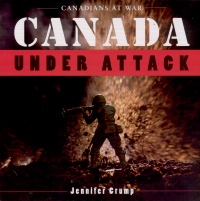| ________________
CM . . . . Volume XVII Number 10. . . .November 5, 2010. 
 |
Canada Under Attack: Canadians at War.
Jennifer Crump.
Toronto, ON: Dundurn, 2010.
203 pp., pbk., $19.99.
ISBN 978-1-55488-731-6.
Subject Headings:
Battles-Canada-History.
Canada-History, Military.
Grades 7-9 / Ages 12-14.
Review by Tom Chambers.
**/4
|
| |
|

excerpt:
They arrested the men and McIntyre reportedly demanded to know by whose authority they were arresting him. “By this authority,” the commander responded, brandishing his bayonet. McIntyre and his companions were taken to Woodstock where a magistrate issued a warrant against them. They were then marched to a prison in Fredericton. Officials gamely offered to release the men if they agreed to quit the area. When McIntyre refused, the solicitor general of New Brunswick assured him that he would supply him with a note that would explain that the man had no choice but to abandon his task or be imprisoned. Again he refused.
Canada Under Attack is a history book for young readers that deals with battles that took place on Canadian soil and also with some that were planned but never occurred. The first category includes the Battle of Quebec in 1759 between the France and England and the War of 1812 between Canada and the United States. The second includes War Plan Red, an American plan for invading Canada, drawn up in 1945 but never put into action. Some of the lesser-known battles rate only a footnote in standard history texts, if they are mentioned at all. The book is unquestionably exciting and difficult to put down, but it has some serious flaws that weaken its value as a text.
One of the more “unusual” battles is discussed in Chapter 12, The Fire Balloons. Large balloons made of paper or silk were used by the Japanese to drop incendiary devices on Canada during the Second World War. They travelled from Japan across both the Pacific Ocean and the Rocky Mountains to Alberta and Saskatchewan.
The book has an index, a bibliography and references. It is also illustrated with black and white reproductions of historical works of art and a number of photographs. These are functional and spread throughout the book. A few historic maps are included as well. These are quite dark and of little help in identifying the places mentioned. Clear maps showing the locations of the battles would have been useful.
There are, in addition, a number of interesting sidebars. These are inserted throughout the book. One example is Attack on Estevan Point in Chapter 11, which deals with attacks by Japanese submarines in the Pacific.
There are many grammatical errors in Canada Under Attack that seriously weaken the book’s value as a text. These occur throughout the book and suggest that the book was poorly edited. A number of examples follow:
Food was scarce and strictly rationed with the choices bits saved for the officers.
When the shelling was at its most intense and crept out during the occasionally lightening of the barrage.
Carleton, who reported a mere six of him men killed.
Red George reached de Salaberry on October 24, but his even with his men the Canadians were still outnumbered.
The U.S. and British government’s struggled to find a peaceful solution.
RCMP records suggest the Langbein was a friendly man.
There are, in addition, a number of examples of sloppy attention to facts and details. Some examples follow:
William 1 selected the Saint John and St. Francis rivers as the border between Nova Scotia and Maine. Maine and Nova Scotia are not contiguous.
By mid 1838………many American members were battle-hardened veterans of the Revolutionary and Civil Wars. The U.S. Civil War was fought between 1861 and 1865.
Campobello Island, the Nova Scotia colony. The island is part of the province of New Brunswick.
The Fenian Brotherhood…had been founded in 1859…..as an offshoot of the Irish Republican Army. The IRA was only founded in 1919 after the failure of the 1916 Easter Uprising.
Wolfe’s army…….most experienced and battle hardened troops ever to launch an invasion of Canada. By 1759, how many invasions with troops had there been?
His targets were the major ports along the U.S.-Canada border. This statement is misleading. Windsor, Ontario, across the Detroit River from Detroit, Michigan, seems to be the only Canadian port close to the border, which is in the middle of the river. Ports on the Great Lakes are a long way from the border.
Two words, votligeurs (militiamen) and abatis (a rampart of felled trees) are used in the chapter on the War of 1812. Since these are not likely to be words understood by the target audience, an explanation would have been helpful. There is no glossary.
The author of Canada Under Attack, Jennifer Crump, has considerable experience as a writer. A freelance journalist and high school teacher, she has written five nonfiction books, including Frommer’s With Kids Toronto and The War of 1812, Junior Edition. She has also had many magazine articles published.
Recommended with reservations.
Thomas F. Chambers, a retired college teacher, lives in North Bay, ON.

To comment on this title or this review, send mail to
cm@umanitoba.ca.
Copyright © the Manitoba Library Association. Reproduction for personal use is permitted only if this copyright notice is maintained. Any other reproduction is prohibited without permission.
NEXT REVIEW |
TABLE OF CONTENTS FOR THIS ISSUE- November 5, 2010.
AUTHORS |
TITLES |
MEDIA REVIEWS |
PROFILES |
BACK ISSUES |
SEARCH |
CMARCHIVE |
HOME |
